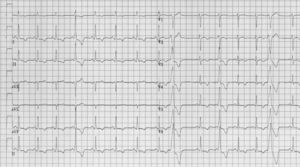Puzzle 2006 12 436 Answer
| Author(s) | A.A.M. Wilde | |
| NHJ edition: | 2006:12,436 | |
| These Rhythm Puzzles have been published in the Netherlands Heart Journal and are reproduced here under the prevailing creative commons license with permission from the publisher, Bohn Stafleu Van Loghum. | ||
| The ECG can be enlarged twice by clicking on the image and it's first enlargement | ||
A 28-year-old, wheelchair bound, female patient with Friedreich’s ataxia presents with an irregular heartbeat. She has no history of syncope or dizziness and no other complaints. Physical examination of the heart reveals no abnormalities. There are neither signs of left nor right heart failure. Her pulse is in principle regular, but occasionally some irregularities are observed. The ECG is depicted in figure 1. An echo is normal.
What is your diagnosis?
Answer
The ECG shows sinus rhythm at a rate of 90 beats/ min. Conduction intervals are normal (PR 120 ms, QRS 90 ms). Aspecific repolarisation abnormalities (terminal negative T waves in the left lateral and inferior leads) are observed. These are more frequently seen in patients with Friedreich’s ataxia and do not seem to have any particular meaning.
There are four wide QRS complexes, one recorded in the extremity leads and three in the precordial leads. Given the similar configuration in lead II (rhythm strip at the bottom) the 1st aberrant QRS complex is probably similar to the 3rd aberrant QRS complex. These complexes are preceded by a short PR interval and ventricular pre-excitation is suggested. The 2nd and 4th aberrant complexes are wider and not preceded by a discernable P wave. Both are followed by a complete compensatory pause suggesting that these complexes have a ventricular origin. The question that subsequently arises is whether all four wide QRS complexes are ventricular extrasystoles or whether both pre-excited complexes and ventricular premature beats are present.
If pre-excitation is suggested then the approximate site of pre-excitation should be given. In this case the suggested Δ-wave is positive in leads I, II and III but negative in leads aVR and aVL. The latter combination is actually impossible with pre-excitation and this makes a ventricular extrasystole originating from the right ventricular outflow track, fused with ventricular activation through the normal conduction system (following the regular P-wave) more likely. Indeed, the initial part of the other wide complexes is similar to the initial morphology of the ‘pre-excited’ complexes. A more likely diagnosis therefore is ventricular extrasystoles with different coupling intervals (and fusion in the 1st and 3rd complex).
